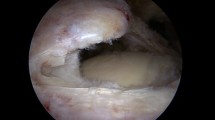Abstract
Introduction
The purpose of this study was to introduce a novel arthroscopic transtendon anatomic repair technique that spares the intact bursal-sided tendon in articular-sided partial-thickness rotator cuff tears (PTRCT) and to present shoulder functional outcomes in patients with symptomatic articular-sided PCRCT that involves more than 50 % of its thickness after arthroscopic repair using a novel technique.
Materials and methods
Eighteen patients with symptomatic articular-sided PCRCT involving more than 50 % of the tendon’s thickness underwent arthroscopic repair using a devised technique. The devised technique restores only the torn articular portion of the rotator cuff at the anatomical footprint using a suture anchor, and preserves the integrity of the corresponding bursal-sided tendon by tying knots at the most lateral bursal side on the subacromial space. Clinical and functional outcome using ASES and Constant scores were evaluated. The structural integrity of the rotator cuff was evaluated by MRI at 6 months postoperatively.
Results
Pain relief and shoulder functional outcomes were encouraging during the recovery phase after operation. ASES (preoperative 54.0 ± 10.3 to postoperative 92.6 ± 8.0), Constant score (61.2 ± 8.5–88.0 ± 5.3), VAS for pain (4.9 ± 2.6–0.6 ± 0.7) improved significantly after arthroscopic transtendon anatomic repair (p < 0.001). No patients had rotator cuff retears on 6-month MRI. No complications related to surgical procedures had occurred.
Conclusion
The devised technique of arthroscopic transtendon repair provided satisfactory functional outcomes without postoperative discomforts. This technique minimizes over-tightening of the articular layer and reduces tension mismatches between the articular and bursal layers, which are considered as important factors for improvement of postoperative shoulder motion.






Similar content being viewed by others
References
Sun L, Zhang Q, Ge H et al (2015) Which is the best repair of articular-sided rotator cuff tears: a meta-analysis. J Orthop Surg 10:84. doi:10.1186/s13018-015-0224-6
Franceschi F, Papalia R, Del Buono A et al (2013) Articular-sided rotator cuff tears: which is the best repair? A three-year prospective randomised controlled trial. Int Orthop 37:1487–1493. doi:10.1007/s00264-013-1882-9
Seo Y-J, Yoo Y-S, Kim D-Y et al (2011) Trans-tendon arthroscopic repair for partial-thickness articular side tears of the rotator cuff. Knee Surg Sports Traumatol Arthrosc 19:1755–1759. doi:10.1007/s00167-010-1362-3
Ji J-H, Shafi M, Jeong J-J et al (2012) Transtendon arthroscopic repair of high grade partial-thickness articular surface tears of the rotator cuff with biceps tendon augmentation: technical note and preliminary results. Arch Orthop Trauma Surg 132:335–342. doi:10.1007/s00402-011-1373-7
Ide J, Maeda S, Takagi K (2005) Arthroscopic transtendon repair of partial-thickness articular-side tears of the rotator cuff: anatomical and clinical study. Am J Sports Med 33:1672–1679. doi:10.1177/0363546505277141
Waibl B, Buess E (2005) Partial-thickness articular surface supraspinatus tears: a new transtendon suture technique. Arthrosc J Arthrosc Relat Surg 21:376–381. doi:10.1016/j.arthro.2004.11.008
Castagna A, Delle Rose G, Conti M et al (2009) Predictive factors of subtle residual shoulder symptoms after transtendinous arthroscopic cuff repair: a clinical study. Am J Sports Med 37:103–108. doi:10.1177/0363546508324178
Shin S-J (2012) A comparison of 2 repair techniques for partial-thickness articular-sided rotator cuff tears. Arthrosc J Arthrosc Relat Surg 28:25–33. doi:10.1016/j.arthro.2011.07.005
Huberty DP, Schoolfield JD, Brady PC et al (2009) Incidence and treatment of postoperative stiffness following arthroscopic rotator cuff repair. Arthrosc J Arthrosc Relat Surg 25:880–890. doi:10.1016/j.arthro.2009.01.018
Lo IKY, Burkhart SS (2004) Transtendon arthroscopic repair of partial-thickness, articular surface tears of the rotator cuff. Arthrosc J Arthrosc Relat Surg 20:214–220. doi:10.1016/j.arthro.2003.11.042
Gonzalez-Lomas G, Kippe MA, Brown GD et al (2008) In situ transtendon repair outperforms tear completion and repair for partial articular-sided supraspinatus tendon tears. J Shoulder Elb Surg Am Shoulder Elb Surg Al 17:722–728. doi:10.1016/j.jse.2008.01.148
Mazzocca AD, Rincon LM, O’Connor RW et al (2008) Intra-articular partial-thickness rotator cuff tears: analysis of injured and repaired strain behavior. Am J Sports Med 36:110–116. doi:10.1177/0363546507307502
Duralde XA, McClelland WB (2012) The clinical results of arthroscopic transtendinous repair of grade III partial articular-sided supraspinatus tendon tears. Arthrosc J Arthrosc Relat Surg 28:160–168. doi:10.1016/j.arthro.2011.08.286
Mihata T, McGarry MH, Ishihara Y et al (2015) Biomechanical analysis of articular-sided partial-thickness rotator cuff tear and repair. Am J Sports Med 43:439–446. doi:10.1177/0363546514560156
Brockmeier SF, Dodson CC, Gamradt SC et al (2008) Arthroscopic intratendinous repair of the delaminated partial-thickness rotator cuff tear in overhead athletes. Arthrosc J Arthrosc Relat Surg 24:961–965. doi:10.1016/j.arthro.2007.08.016
Park MC, Jun BJ, Park CJ et al (2009) Biomechanical analysis of a knotless transtendon interimplant mattress repair for partial-thickness articular-sided rotator cuff tears. Am J Sports Med 37:2427–2434. doi:10.1177/0363546509340227
Spencer EE (2010) Partial-thickness articular surface rotator cuff tears: an all-inside repair technique. Clin Orthop 468:1514–1520. doi:10.1007/s11999-009-1215-x
Conway JE (2001) Arthroscopic repair of partial-thickness rotator cuff tears and SLAP lesions in professional baseball players. Orthop Clin N Am 32:443–456
Author information
Authors and Affiliations
Corresponding author
Ethics declarations
Conflict of interest
The authors declare that they have no conflict of interest.
Rights and permissions
About this article
Cite this article
Shin, SJ., Jeong, JH., Jeon, Y.S. et al. Preservation of bursal-sided tendon in partial-thickness articular-sided rotator cuff tears: a novel arthroscopic transtendon anatomic repair technique. Arch Orthop Trauma Surg 136, 1701–1708 (2016). https://doi.org/10.1007/s00402-016-2546-1
Received:
Published:
Issue Date:
DOI: https://doi.org/10.1007/s00402-016-2546-1




